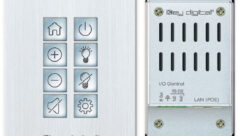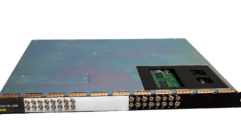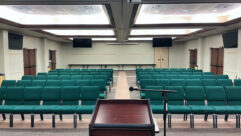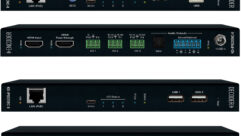Digital Signal Routing and Distribution
Feb 1, 2002 12:00 PM,
By Barry Albright
REMEMBER WHEN people just said, “patch panels”? Nowadays, sophisticated routing fabrics and control systems can handle many signal types, and the routing and distribution of digital audio and video is no longer the exclusive domain of broadcast and teleproduction facilities. High-quality digital signal routing has found its way into theme parks, houses of worship, government agencies and other varied applications. It’s important to explore the options for these systems before making a choice among the available technologies and topologies.
TOPOLOGIES, FABRICS AND CONTROL SYSTEMS
there are two basic topologies commonly used today. In a central equipment pool, expensive pool resources are allocated as needed to the various functional areas in a facility, for example, on-air broadcast, production and news. In a distributed topology, distributed resources or islands are dedicated to each specific function. At most facilities a combination of the two topologies evolves, based on factors such as market forces, facility precedence, individual personalities and corporate culture. The choice of a new routing switcher fabric and control system will also be governed by these factors. With the advent of digital video and the development of common ASICs, the hardware fabric performance is becoming more and more similar among some of the high-profile vendors. It is the control system that is now the dominant factor driving the choice of signal routing systems.
The most basic topology for routing switchers is the X/Y matrix, with x inputs by y outputs. It is easy to understand and control. And it is ideally suited for the central equipment pool topology, but the main disadvantage is that the price tag grows with the number of inputs and outputs. The enormous cost of large X/Y matrices led to the development of control system algorithms that allowed a reduction of the number of cross-points. These were originally developed by the telephone industry and subsequently modified for broadcast use. There are three common techniques for reducing the number of cross-points, each with its own set of strengths and weaknesses: multistage cross-point arrays, path-finding or distributed fabric arrays, and time division multiplexing (TDM) virtual arrays. There are also packet, cell and network-based fabrics, which are just starting to come into use.
Multistage Systems
The most common implementation is a 3-stage topology. This topology consists of small X/M input matrix blocks, moderately sized M/N middle or intermediate matrix blocks and small N/Y output matrix blocks. Multistage topologies can yield significant cost savings for large fabrics.
One of the main concerns with the 3-stage architecture has to do with blocking, or not being able to complete a required connection through the fabric. For the telephone company, this was not a big issue — they simply used busy signals or an all-circuits-in-use recording. But this is unacceptable in applications that rely on real-time signal distribution, so sizing and control algorithms were developed to virtually eliminate the possibility of a block.
One drawback of multistage topology, however, is a slight degradation of performance. Each connection goes through the underlying X/Y blocks three or more times. This was a major concern for traditional analog audio and video fabrics, but is less of a concern for today’s digital fabrics.
Pathfinding Fabrics
These involve the physical distribution of small X/Y matrices, interconnected by trunk or tie lines. This topology can realize enormous cost savings where the island topology is dominant. While yielding the greatest savings in hardware, it is the most complex topology to control and requires careful planning before deployment.
A unique benefit of pathfinding is the ability to complete format conversions within the switching fabric. This is particularly important if you are dealing with multiple signal types (analog/digital and compressed/uncompressed). A few format converters can be integrated into the fabric and transparently routed through, based on source and destination format requirements. Modern control systems should have this capability. Be sure to purchase this type of system from an experienced vendor.
Another topic that is closely related to the idea of pathfinding and tie-line management is the growing need to provide a seamless control system for routing switchers located in separate facilities. When choosing a control system, it is important to look for the ability to use standard local area networking (LAN) and wide area networking (WAN) architectures, including the Internet, to provide extended control functionality over distances.
Time Division Multiplex Fabrics
While not yet economically feasible for full-bandwidth digital video transport, TDM fabrics are now an attractive option for AES digital audio routing. The cost of designing and building this type of fabric continues to drop rapidly due to advances in ASIC technology and high-speed serial transports on copper and fiber. TDM can be used to implement a large virtual X/Y fabric in a central frame or a distributed fabric using add-drop mux/demux boxes interconnected by high-speed serial copper or fiber trunks.
Every topology option requires tradeoffs, and this one is no different. The virtual fabric created in a TDM router is based on uniform time slots, each input or output corresponding to a specific time slot assignment for its sample transport. Normally this implies the existence of a synchronous system architecture extending beyond the fabric and throughout the facility (though there are exceptions). However, if the system is not frequency-locked, then the fabric must perform sample rate conversions, which inherently modify or distort the signal. (In fact, the closer the input sample rates are to the output sample rates, the worse the distortion.) In this way, proper digital audio facility design is akin to system timing for NTSC or PAL analog video. You will probably not be able to avoid sample rate conversion entirely, due to the multiplicity of rates you will encounter, e.g., 32, 44. 1, 48, 96, 192kHz, varispeed, and both 29.97 and 30Hz video frame rates.
Make sure you understand your needs and what the vendor is offering before choosing virtual or TDM routing fabrics. For example, avoiding audio pops when switching Dolby E multichannel audio compressed signals requires a synchronous facility, so that switching occurs within the time fences defined by Dolby E, which are based on video frames. Fortunately, there are products available that offer a good compromise of synchronous vs. asynchronous features and control system flexibility.
PACKET-, CELL- OR NETWORK-BASED SWITCHING
while packet-based switching has been around quite a while, it has only recently entered the area of digital audio/video routing. Motivating this move are protocol standardization, the Internet, inexpensive computers and the availability of inexpensive networking components that comprise the physical and protocol layers. Gigabit Ethernet, IEEE-1394, USB physical layers and IP and ATM protocol layers fit loosely into this arena.
The development of MPEG-2, -4 and -7 video compression and AC-3, MP3 and Dolby E for audio compression have added a whole new range of possibilities for distribution of video and audio (and now metadata) using packet-based fabric or network topologies. These technologies can distribute non-real-time video as files or transfer real-time video at lower bit rates (for applications with lower quality requirements, such as desktop monitoring, Internet video streaming, or remote site monitoring). Keep in mind that high-quality, real-time signal transport will still require full-bandwidth signal paths.
Web-based control and monitoring of switching fabrics and distribution equipment is also starting to show up on the market. This is an easily leveraged technology available from the PC/workstation market, so look for it to become commonplace. A facility infrastructure designer needs to consider these technologies as viable options. But beware of becoming overwhelmed with the possibilities: Make sure you understand the tradeoffs in quality and content-delivery latency before jumping in.
Asynchronous Transfer Mode Fabric
Depending on the path parameters, ATM fabrics, while cell-based, do have some nice characteristics that can be defined by the client. An ATM cell is analogous to an IP packet with a fixed 53-byte length, five bytes for the header and 48 bytes for the payload. ATM can guarantee quality of service beyond the facility walls, and even internationally. ATM is independent of the physical layer. It is a method of transport within the synchronous digital hierarchy and SONET. ATM is typically considered a step above IP transport, and you’ll see IP transported by ATM, but not ATM transported over IP. Therefore, when considering your networked infrastructure, consider ATM as a possibility. Look to ATM in the future for inter-facility and inter-city transport of lightly compressed video and audio using public networks.
Optical Fabrics and Wavelength Division Multiplexing
There have been several demonstrations of optical switch fabrics in the past two decades. One would think that, by now, optical interconnect and optical switching would have replaced traditional facility infrastructure. Why this hasn’t happened is mainly due to economic reasons. While the technology does exist, it’s still far too expensive compared to traditional methods. Electrical/copper interfaces, even at 1.485GB/s(uncompressed HDTV), are much cheaper than their optical counterparts. As the telecommunications industry progresses toward low-cost electrical/optical conversion, transport and switching, the video industry will also begin to employ the technology. But don’t hold your breath: Full-bandwidth video transport is probably a decade away.
CONTROVERSIES AND HAZARDS
beware: the major routing and control system vendors are fierce competitors. Some actively propagate fear, uncertainty and doubt regarding others’ products. This makes your job more difficult as you have to sort through the propaganda. Here are some signposts to help guide you.
Non-reclocked vs. Reclocked Serial Digital Video
In the early days of serial digital video distribution, a great debate raged over non-reclocked vs. reclocked output. Today there are hundreds of thousands of installed non-reclocked signal paths that operate without any problems. Non-reclocked paths work if two conditions are present: One, there is good intrinsic signal fidelity in the fabric. Two, the path consists of a processing device that generates pristine serial output to a processing device that subsequently deserializes the signal (generally a receiver with good input jitter tolerance vs. frequency). A properly-designed serial digital receiver/deformatter will have a much wider IJT transfer characteristic than an intermediate reclocker.
The reason reclocking seems to be a good thing is that it does reduce jitter. Normally this is accomplished by restricting the reclockers’ PLL bandwidth. For a receiver/deformatter; however, one wants to maximize PLL bandwidth, so as to maximize the receivers’ jitter tracking range with respect to frequency. The PLL bandwidth of the reclocker placed in a router output is at best a compromise between conflicting requirements. It is entirely conceivable that a poor-quality input source could become corrupted in the router reclocker but be accepted by the subsequent device’s receiver/deformatter without error due to its wider PLL bandwidth. That is, it has better IJT when the reclocker is not present.
A properly designed reclocking device must, by definition, have two PLLs and an elastic buffer between the wide-bandwidth PLL receiver side and the narrow-bandwidth PLL transmission side. Unfortunately, there are no single-chip ASIC reclocker ICs currently available that provide this functionality, either for SDTV or HDTV. Therefore, you may actually be better off without reclocking in your routing fabric for point-to-point and point-to-multipoint paths. [See SMPTE Engineering Guideline SMPTE EG33, for a better understanding of this subject.]
Passing SDTV through HDTV fabric obviates any need for reclocking, due to the requirements of HDTV fabric design. If you insist on SDTV reclocking in an HDTV product, you are going to pay for something totally unnecessary. The SDTV non-reclocked multipass performance of today’s HDTV fabrics approaches that of the present generation of SDTV reclocked products.
Virtually all of the major vendors offer reclocking at HDTV rates; however, at this infancy stage of HDTV SDI deployment, HDTV reclocking should be a user-selectable option. This is because some serializers and receiver/deformatters for HDTV are poorly implemented, in which case the reclocker may actually hurt you.
Synchronous AES vs. Asynchronous AES
The issue of synchronous vs. asynchronous AES fabrics is more a facility theology issue than a competitive vendor one. There is a consistent lack of understanding of how to successfully implement digital audio. Digital audio routing is akin to analog video routing and system timing. If you don’t synchronize your digital audio facility properly, you get pops, ticks and clicks at switch points, or all the time if you try to pass an asynchronous signal through a purely synchronous fabric. If you’re a pragmatist, then you’ll be happy with full-time sample rate conversion. But if you’re a purist or perfectionist, then you need to think about the old NTSC or PAL video timing requirements and do the same for your digital audio.
Deterministic vs. Non-deterministic Control
Deterministic control systems are those that have a guaranteed latency or delay between a command’s initiation and its actual execution. For manual push-button control, deterministic response is not important because the response of the control system is usually faster than human response time. It is most important when controlling multiple devices that need to be in sync, as is the case with legacy linear editing systems and, perhaps, frame-accurate automation systems.
Most modern control systems are based on Ethernet backbones, which are inherently non-deterministic. If the amount of traffic is kept low on the backbone, there is a reasonable chance that commands will arrive within acceptable time fences. This is why control system vendors want the control backbone isolated from corporate LAN, using bridges and routers. Vendors can use time stamping and command queuing to minimize the effects of non-determinism, but there is always a possibility that a command may not be delivered when expected.
Real-time vs. Non-real-time and Full Bandwidth vs. Compressed
The explosive growth of the Internet and inexpensive, powerful, PC workstations has made it common to edit and create graphics using workstations and LAN technology. This makes it difficult to determine how much full-bandwidth fabric and how much compressed and/or non-real-time fabric is needed in a facility. The full-bandwidth fabric is usually quite expensive, while LANs, SANs and VLANs are quite inexpensive, even for the Gigabit versions.
On one extreme, some people predict the complete disappearance of the traditional full-bandwidth fabrics in the next five years. On the other extreme are those who insist that LANs, etc., just won’t fulfill their distribution needs. It is already apparent that the industry is in transition toward the use of non-real-time and compressed material transfer. But at the same time, size and sales of full-bandwidth fabrics are actually increasing. Full-bandwidth fabrics are here to stay for the foreseeable future.
MAKING THE RIGHT CHOICE
before specifying your system, examine your present and future requirements, based on the following criteria:
- Existing InfrastructureWhat are its limitations and strengths? Build on what works, change what doesn’t. Can the new control system work with the existing fabrics you want to keep?
- Future Expansion PlansHow long do you plan to keep the new or upgraded infrastructure? Ten years is not unreasonable for the switching fabric and control system, and you should plan for expandability in both.
- Emerging TechnologiesHow can they be applied to reduce cost or enhance capability? What are the market forces driving their emergence?
- What Can You Afford?Prioritize your requirements. You may need to make compromises based on the available products. It is unlikely that one vendor will meet every one of your requirements, so research many offerings and the companies behind them. Find out how well the product fits the requirements. Use the free expertise of the vendor to clarify the product-need match. A vendor may offer an acceptable workaround or a better way than yours to accomplish what you want to do. Observe how well the company works with you in this process.
FINAL QUESTIONS & THOUGHTS
when choosing a vendor and a system topology, there are a few more questions you should consider. For instance, is it likely the vendor will still be around to support your future expansion needs? How well do they support their legacy and current products? Look at their track record and actively investigate several user references.
As for the product, does it meet the industry standards and regulatory requirements, such as SMPTE, UL, FCC and CE? Ask for proof of compliance and performance specs if you have any doubts. This is important because often it is the end user, not the vendor, who is responsible for compliance to regulatory standards.
Look at the long-term budget. Consider the costs of ownership including product reliability, facility real estate, power consumption and warranty and/or maintenance contract options. How much will it cost to expand the system in the future? Note the size breakpoints where input distribution and/or output combiners become necessary. These will greatly affect the cost of your system. Brand X may have the lowest price for today’s needs, but the added cost of a distribution amplifier and/or combiner may give you a real shock when you go to expand your system later.
Finally, document your requirements so that your selected vendors can bid on them. Pick your top two or three vendors and seek competitive quotes from each. Making the right choices in your facility infrastructure is vital. The worst mistake you can make is rushing into a purchase decision without understanding what you really want to accomplish. Understanding and applying the available technology choices can seem overwhelming, but it is manageable and rewarding if you invest your time wisely. Use whatever resources are available to you, especially free resources from vendors you are considering working with. Once you have done your homework, you should be able to make your purchase decisions with confidence.
Barry Albright is a member of the Thomson Multimedia Broadcast Solutions technical staff in Media Networking and Control, Salt Lake City, Utah.
Terminololgy Cheat Sheet
AES digital audio: Digital audio signals that conform to Audio Engineering Society standards.
ASIC: Application-specific integrated circuit.
ATM: A method of transporting asynchronous signals within the synchronous digital hierarchy (SDH) or synchronous optical network (SONET) used for telecommunications.
cell-based switching: Transmission of data in datagram cells. Also called “packet-based switching.”
central equipment pool: A facility or topology where most resources reside in a central location and are shared among users or control rooms.
distributed or island topology: System layout in which control rooms are substantially self-contained, with their own set of resources (e.g., servers, cameras, switchers, etc.). Compare central equipment pool.
fabric (as used in this article): Switching matrix.
full bandwidth: Original, exactly replicated and/or uncompressed digital video or audio; opposite of partial or compressed.
IJT: Input jitter tolerance. The amount of jitter vs. frequency that a digital receiver can tolerate at its input.
IP: Internet protocol.
Mux: Multiplexing. Bringing together of signals; De-mux means splitting signals apart.
PLL: Phase-locked loop.
packet-based switching: See cell-based switching.
receiver: A serial digital video receiving device.
reclocker: A device that restores the timing properties of a serial digital video signal.
serializer: A device that makes parallel data into a time-sequential series of data.
TDM: Time division multiplexing. A method where input samples, cells or packets are assigned to unique time slots, each corresponding to a channel or output. A TDM fabric is known as a virtual matrix. Compare traditional switching matrix (physical crosspoint array); AKA space matrix.
topology (as used in this article): The specific way a facility is organized. See central equipment pool and distributed/island topology.










